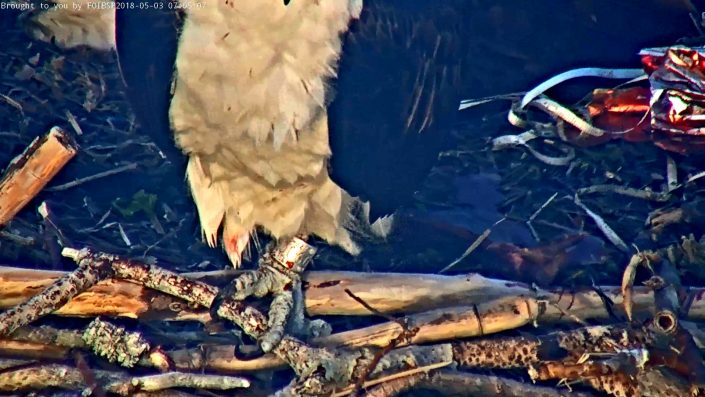Identifying “Bandit” at Pete McLain Osprey Cam Nest
The Amazing History of a Breeding Adult Male Osprey at Island Beach State Park
by Ben Wurst, Habitat Program Manager

Around 3% of ospreys who were banded with USGS aluminum bird bands as nestlings in New Jersey are re-sighted after fledging or leaving their nest. Most of those recoveries or resightings are centered around mortality based events where a bird is injured or killed and the band is then close enough to read. Since the numbers on the leg bands are so small, it is often hard to read when they are still alive. However, when enough photos are obtained or a camera is installed on a nest then the likelihood of reading the band on a live bird increases.
The latter is the case with one particular bird, named “Bandit” at the Pete McLain Osprey Cam Nest, which is located along the road inside Island Beach State Park. This male osprey showed up at this nest in late May 2013 after the resident male did not return to the nest after a strong storm. The pairs clutch of eggs was predated by crows and a few male ospreys battled over who would mate with the female. Friends of Island Beach member Bonnie Delaney explains and witnessed the fierce competition at the nest:
“Original male disappeared after a storm just before Memorial Day 2013, right about time 3 eggs in nest due to hatch. Female left the nest for food. Bandit was one of several males fighting to get into nest. Female accepted him. I was there day ospreys were fighting. So awesome!”
The male who won the battle was banded with a USGS band. Since then, no one has been able to read his band until now. Photographers Karl M. Soehnlein and Alec Malyon took photos of him this spring which revealed part of his band: 665, but that was only a piece of the puzzle. A full band number sequence on an osprey band is 9 digits long (xxxx-xx665), but I was still able to search our banding database to be able to see if I got a hit from the 665 combo. I had two hits, one of which was from Sedge Island WMA!
I know that male ospreys return to nest in very close proximity to their natal areas and female wander away. So, I believed that this was indeed a bird who was banded at Sedge Island, but I needed more photos to really confirm it was him. On Thursday morning, I woke up and tuned into the Pete McLain Osprey Cam run by Friends of Island Beach State Park. I saw that Bandit was sitting on the edge of the nest with a clear view of his band! I took a few stills from the camera which allowed me to confirm his band #: 0928-00665.

After getting his full band number, I again searched our database and found his banding record. He was banded on June 26, 2009 at nest # 123-A-001 or #313 on Osprey-Watch and was the only nestling produced from that nest that year. Digital banding records said that I banded him, but when I went to see if I had any photos of him being banded, I found this gem:

I couldn’t believe that I actually had a photo of him being banded! I also found out that it wasn’t me who banded him, but it was Dr. Erica Miller, a veterinarian with Tri-State Bird Rescue with help from Jim Shissias. They were at Sedge Island for a ENSAC (Endangered & Nongame Species Advisory Committee) meeting. I was there to bring them out to survey an osprey nest. We only banded one nestling that day and it turns out that it was Bandit!
Like I said earlier, it is very hard to read a USGS band on a live bird, but when possible it allows us to learn a lot about their life history! For anyone who watches a nest, remember that you can view all known nests and report osprey nest activity online on Osprey-Watch.org. We use the data in our annual reports and it is also used by government officials, structure maintenance crews, etc…
Thanks to all the photographers and Friends of Island Beach State Park for the great view of their nest!
- View the Pete McLain Osprey Cam
- Learn more about the New Jersey Osprey Project
- Read our latest NJ Osprey Project email update and subscribe to our mailing list
Discover more from Conserve Wildlife Foundation of NJ
Subscribe to get the latest posts sent to your email.
Leave a Comment
Excellent report! Thanks for all the work that you do.
Jim
Hi Ben,
Thanks for this fantastic report! You’re the Sherlock Holmes of the Osprey community! How exciting to be able to identify him and have that close connection. Great work.
Lisa
I love piecing together a puzzle like this! 🙂
Comments are closed.